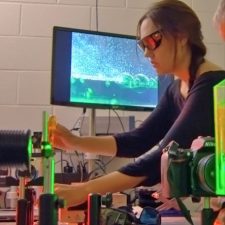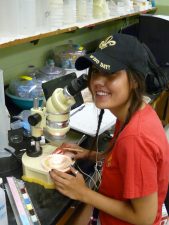Study Finds UVB Radiation Increases Oil Toxicity in Marine Copepod Larvae
– JANUARY 12, 2017
Scientists conducted laboratory exposure experiments to assess the effects of dispersed crude oil, Corexit 9500A dispersant, and natural ultraviolet B (UVB) radiation on early larval stages of planktonic copepods (“nauplii”). The researchers found that chemically-dispersed oil significantly reduced survival, growth, and movement of copepod nauplii compared to other treatments. UVB radiation further elevated mortality rates of copepod nauplii up to 4 times and decreased naupliar growth rates compared to treatments without UVB radiation. The authors published their findings in Chemosphere: Influence of UVB radiation on the lethal and sublethal toxicity of dispersed crude oil to planktonic copepod nauplii.
Some crude oil compounds, such as polycyclic aromatic hydrocarbons, absorb UVB radiation from the sun, which can cause photo-enhanced toxicity of crude oil. However, most studies that investigate crude oil toxicity on marine zooplankton use artificial light with no UVB radiation. This study’s team sought to bridge that knowledge gap because planktonic copepods are key components of marine pelagic ecosystems. Copepod nauplii are the most abundant forms of metazoans on the planet and the main prey of many fish larvae. However, little is known about lethal and sublethal effects of dispersed crude oil and chemical dispersants on these important creatures.
Researchers conducted 48-hour exposure experiments (using different concentrations of mechanically and chemically dispersed crude oil ranging from 0.5 to 2 µL L-1) to determine the effect of UVB radiation on the oil toxicity to nauplii of the copepods Acartia tonsa, Temora turbinata and Pseudodiaptomus pelagicus. The team chose these toxicant exposure concentrations because of documentation showing them to be in the low range typically found in the water column after crude oil spills and/or dispersant applications (McAuliffe et al., 1981; Wells, 1984; Lichtenthaler and Daling, 1985; Clayton et al., 1993; Mukherjee and Wrenn, 2009; National Commission on the BP Deep Ocean Horizon Oil Spill and Offshore Drilling, 2011).
The team collected adult copepod specimens from the Aransas Ship Channel and Corpus Christi Bay and raised them in the laboratory. Nauplii ingested oil droplets and their mortality rate rose as crude oil concentration increased. All experimental treatments reduced growth and swimming behavior of nauplii compared to controls, with dispersant-treated oil in the presence of UVB radiation causing the greatest reductions. Control treatments did not reveal harmful effects of UVB radiation alone to copepod nauplii.
The authors noted that, in addition to direct lethal effects, the sublethal effects of dispersed crude oil may have important implications on planktonic copepod recruitment and population dynamics. Their results support previous studies that indicate that small zooplankton, especially early-life stages and ciliates, are particularly sensitive to chemically dispersed oil and, therefore, highly vulnerable to the impact of oil spills and dispersant applications in marine environments. They also emphasized the importance of including natural sunlight in petroleum toxicological studies and models to ensure more accurate estimation of oil spills’ potential impact on marine zooplankton.
Data are publicly available through the Gulf of Mexico Research Initiative Information & Data Cooperative (GRIIDC) at R1.x140.125:0009.
The study’s authors are Rodrigo Almeda, Tracy E. Harvey, Tara L. Connelly, Sarah Baca, and Edward J. Buskey.
************
This research was made possible in part by a grant from the Gulf of Mexico Research Initiative (GoMRI) to the consortium for Dispersion Research on Oil: Physics and Plankton Studies (DROPPS) and the consortium for Dispersion Research on Oil: Physics and Plankton Studies II (DROPPS II). Other funding sources include the National Science Foundation Research Experiences for Undergraduates Program (Grant OCE-1062745) and the Villum Foundation.
The Gulf of Mexico Research Initiative (GoMRI) is a 10-year independent research program established to study the effect, and the potential associated impact, of hydrocarbon releases on the environment and public health, as well as to develop improved spill mitigation, oil detection, characterization and remediation technologies. An independent and academic 20-member Research Board makes the funding and research direction decisions to ensure the intellectual quality, effectiveness and academic independence of the GoMRI research. All research data, findings and publications will be made publicly available. The program was established through a $500 million financial commitment from BP. For more information, visit https://gulfresearchinitiative.org/.
© Copyright 2010-2017 Gulf of Mexico Research Initiative (GoMRI) – All Rights Reserved. Redistribution is encouraged with acknowledgement to the Gulf of Mexico Research Initiative (GoMRI). Please credit images and/or videos as done in each article. Questions? Contact web-content editor Nilde “Maggie” Dannreuther, Northern Gulf Institute, Mississippi State University (maggied@ngi.msstate.edu).







